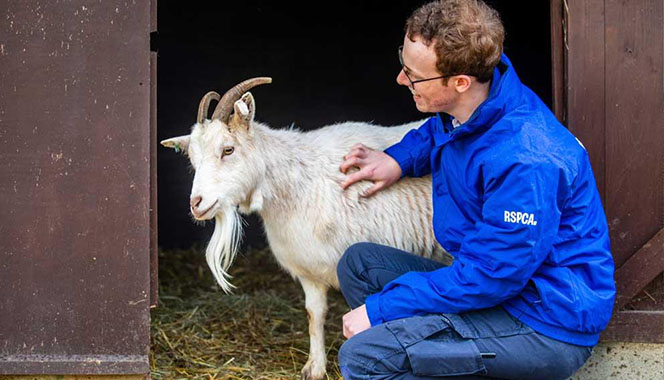- Find a Pet
- Advice and Welfare
- Ways to Give
- Get Involved
- What We Do
- Search
- My RSPCA
- Report a concern
- Sponsor
-
Colour modeVivid Calm
Transporting your pet goats
Journeys and getting on and off vehicles is stressful for goats. The movement, sights, sounds and smells are unfamiliar. You need to plan the journey carefully, thinking about the goat’s welfare at all times. Put them through as few journeys as possible, and make those journeys as short as possible.
Read on for our guidance on how to reduce stress for your goats when they’re on the move. And find out more about the legislation on moving goats in the UK.

The vehicle
You’ll need to find a suitable vehicle for moving your goats, one that’s designed to carry livestock and has compartments for the animals. You can buy, lease or borrow the vehicle, but if borrowed, clean and disinfect it before and after use to cut down on the risk of disease. Check with previous owners and lease companies that the vehicle has been thoroughly cleaned before you use it.
A non-slip material on the floor, such as rubber matting, will stop the goats falling during the journey. They’ll also need straw bedding. Cover anything that could harm the goats if they bump into them, such as door handles, bolts, hinges and corners. And make sure that exhaust fumes can’t build up inside the trailer.
Loading and unloading the goats
Avoid sudden movements and loud noises. You can gently lift smaller goats used to being handled into the vehicle. Larger goats and those not used to being handled will need a ramp. This should have a non-slip surface and a way to make sure they can’t fall off the sides, such as side-gates.
In advance, prepare a short (if possible), fenced route between the trailer and the goat accommodation.
Remember that goats may be harder to handle when they’re being unloaded after the journey.
The journey
Think about the route and time of day of the journey and how to avoid traffic jams, heat, and undue stress for the goats. Drive carefully, braking and accelerating smoothly, and drive slowly around corners and over uneven surfaces.
If the journey’s short, goats shouldn’t need food and water while travelling if they've had access to these leading up to the start of the journey. When the weather's hot or humid, you'll need to provide them with water more regularly.
Once you arrive, offer the goats water and some forage (e.g. hay) or browsing material.
Sick and injured goats
Call out a vet to look at sick and injured goats at home, so you can avoid transporting them.



